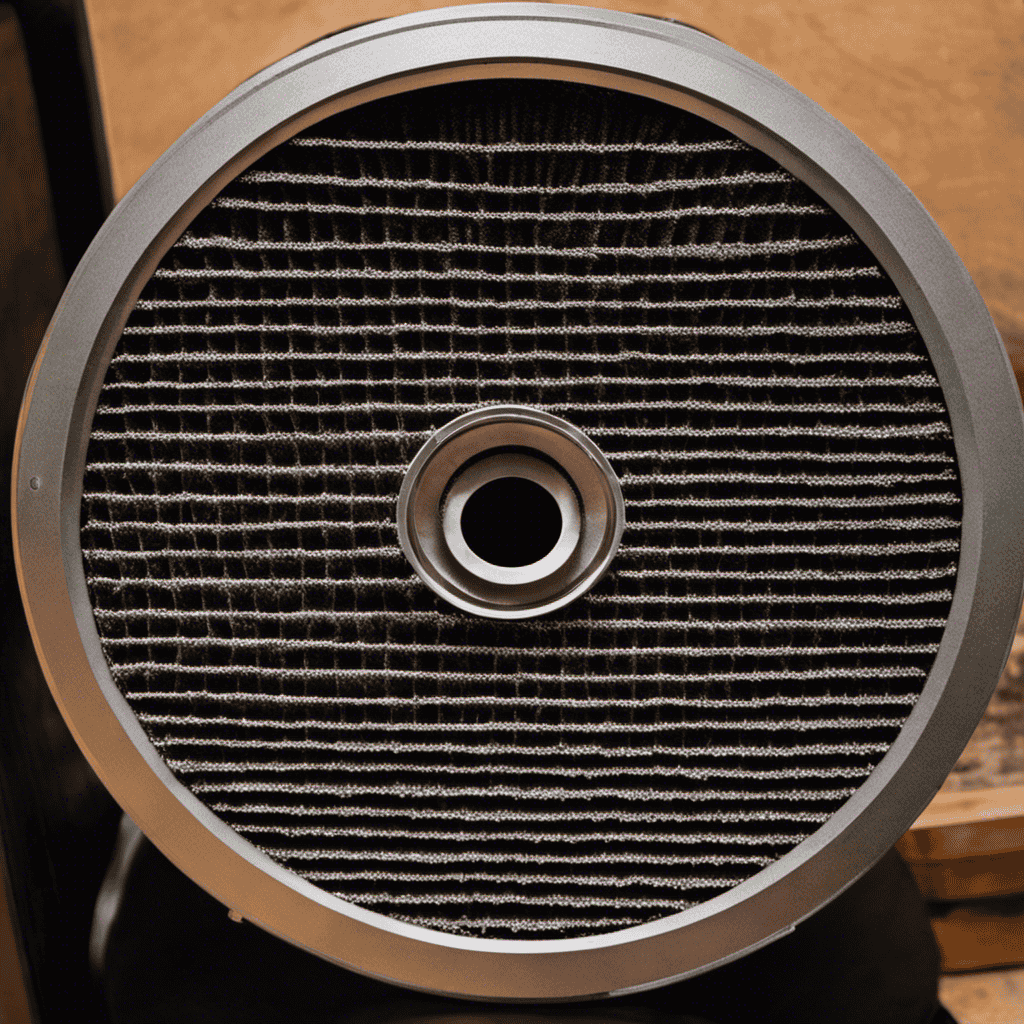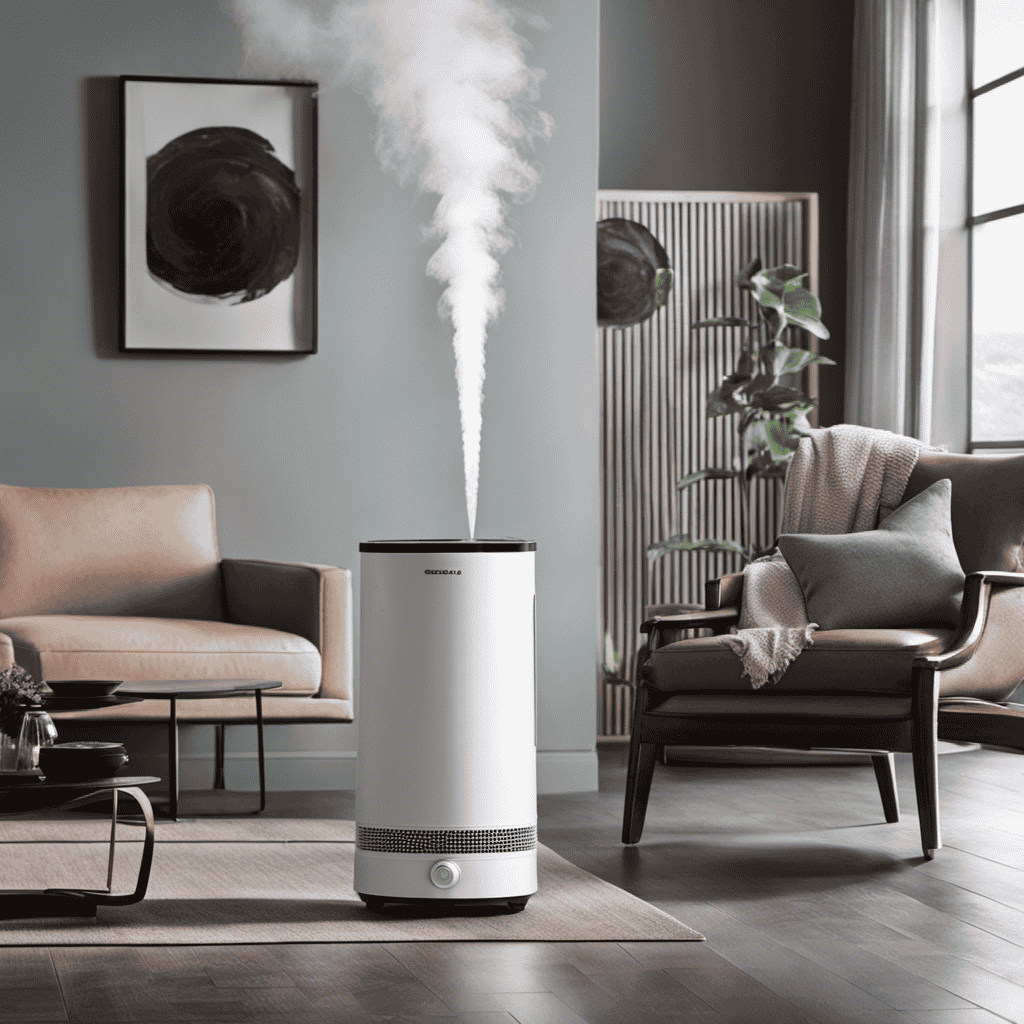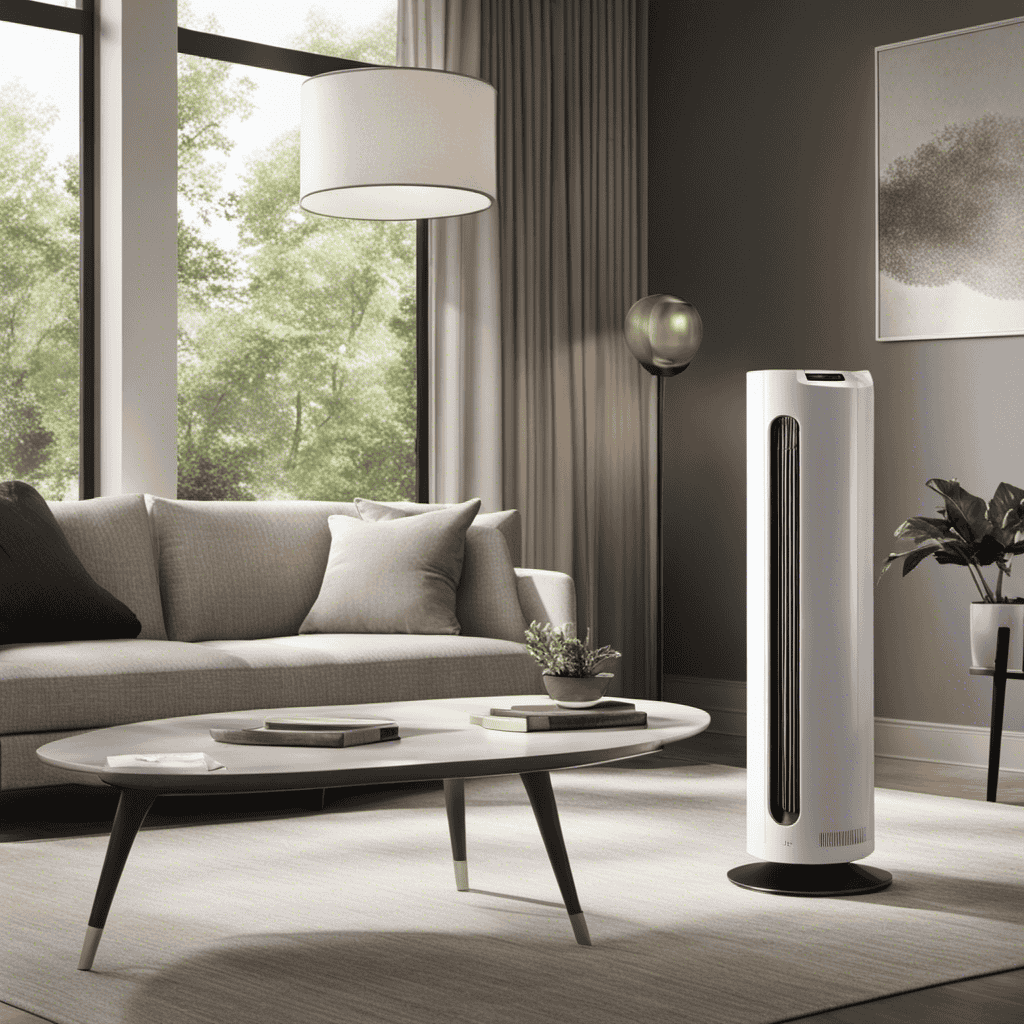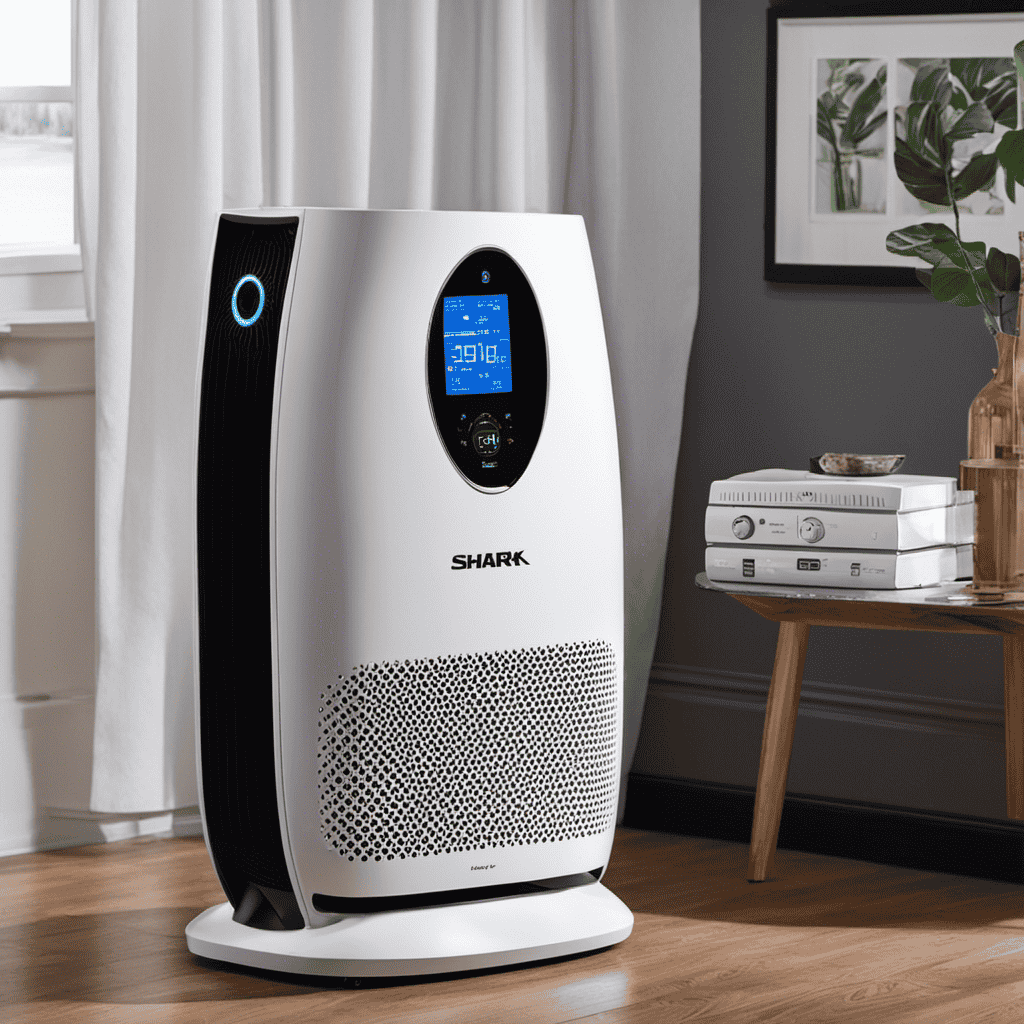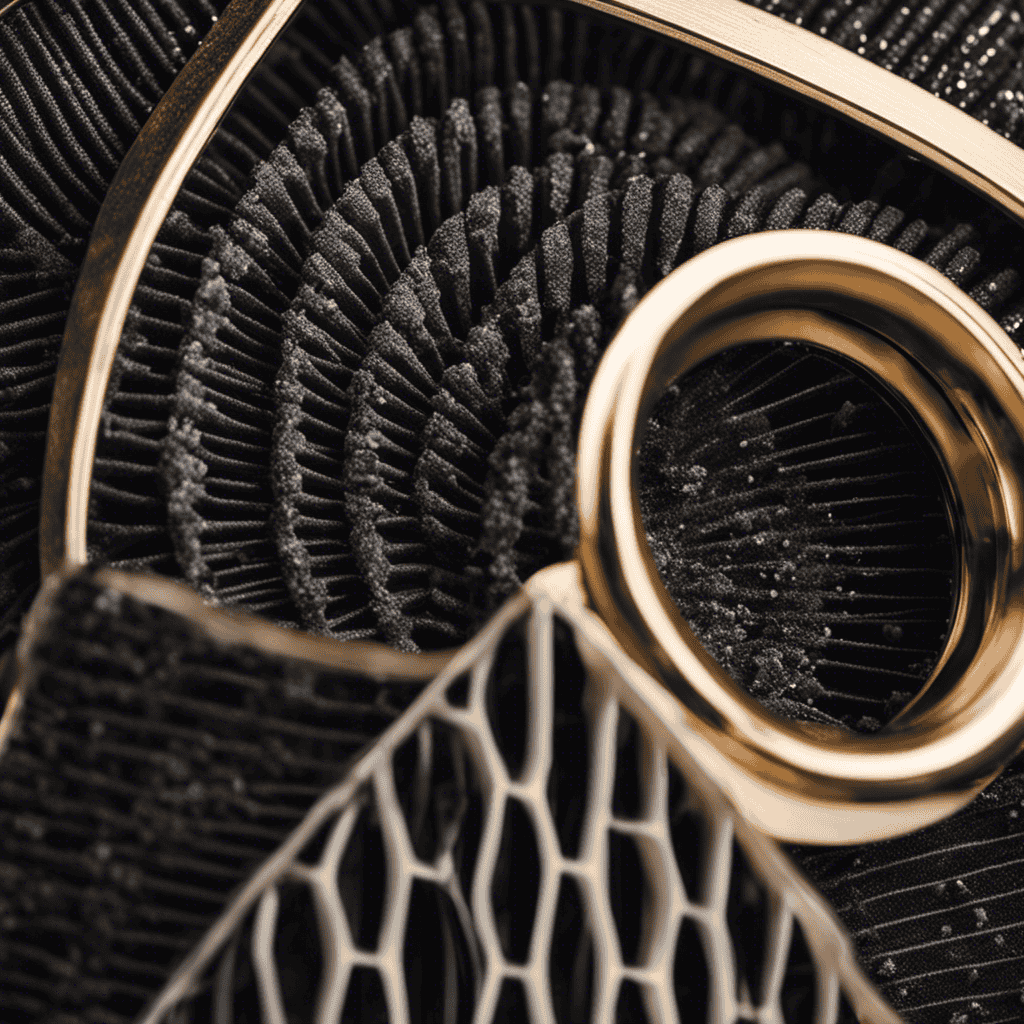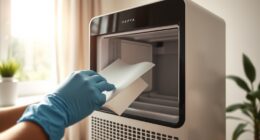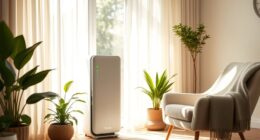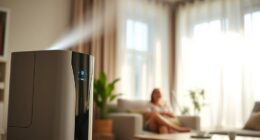You may believe that determining when it is time to change the HEPA filter in your air purifier is a challenging task. However, I can guarantee you that it is not as complex as it may appear.
In this article, I will provide you with clear signs that indicate when it’s time for a new filter. From decreased air purifier performance to an increase in allergies or respiratory issues, there are several indicators that can help you determine if your HEPA filter needs replacement.
So, let’s dive in and learn how to keep the air in our homes clean and fresh.
Key Takeaways
- Signs of reduced air quality include increased allergies or respiratory issues, worsening asthma symptoms, allergies triggered by poor air quality, respiratory infections caused by poor air quality, and fatigue, headaches, and difficulty concentrating due to poor air quality.
- Maintaining good air quality can be achieved by keeping the living space clean, using a high-quality air purifier with a HEPA filter, maintaining proper ventilation, using allergen-proof covers for pillows and mattresses, and minimizing exposure to allergens such as dust mites, pet dander, and pollen.
- Indicators of needing a new HEPA filter include the presence of a filter change indicator, increased allergy symptoms, significant accumulation of dust on surfaces, and the use of sensor-based technology, timers, or indicator lights to ensure optimal efficiency.
- The importance of filter change indicators lies in their ability to detect a decrease in air purifier efficiency using sensor-based technology, calculate when to replace the filter using timers, visually indicate the need for a new HEPA filter using indicator lights or display panels, and ensure optimal air purifier efficiency.
Signs of Reduced Air Quality
If you’re experiencing increased allergies or respiratory issues, it’s a sign of reduced air quality. Poor air quality can have significant health effects, such as worsening asthma symptoms, triggering allergies, and causing respiratory infections. It can also lead to fatigue, headaches, and difficulty concentrating.
To improve indoor air quality and alleviate these symptoms, using an air purifier can be beneficial. An air purifier helps remove harmful pollutants, allergens, and irritants from the air, creating a healthier environment to breathe in. It filters out particles like dust, pollen, pet dander, and mold spores, which can be particularly troublesome for individuals with allergies or respiratory conditions.
Increase in Allergies or Respiratory Issues
There’s been an increase in allergies or respiratory issues lately. It’s important to address these concerns and take steps to prevent further symptoms. Here are three key points to consider when it comes to allergies prevention and air quality improvement:
-
Keep your living space clean:
Regularly vacuum, dust, and mop to remove allergens such as dust mites, pet dander, and pollen. Use allergen-proof covers for pillows and mattresses to minimize exposure. -
Use an air purifier:
Invest in a high-quality air purifier with a HEPA filter. HEPA filters are designed to capture airborne particles, including allergens, and improve indoor air quality. -
Maintain proper ventilation:
Ensure good airflow in your home by opening windows when the weather permits. This helps to reduce indoor pollutants and freshen the air.
Decreased Air Purifier Performance
When it comes to air purifiers, there are a few key indicators that can help determine if the filter needs to be changed.
One of these indicators is the presence of a filter change indicator, which is typically a light or notification that alerts the user when it’s time to replace the filter.
Additionally, if you find yourself experiencing increased allergy symptoms or noticing a significant accumulation of dust on surfaces, it may be a sign that the air purifier’s filter is no longer effectively capturing allergens and pollutants.
Filter Change Indicators
You’ll notice that the filter change indicator on your air purifier will let you know when it’s time to replace the HEPA filter. This feature is designed to ensure optimal air purifier efficiency and maintain clean indoor air quality.
Here are three key aspects of filter change indicators:
-
Sensor-based technology: Many modern air purifiers are equipped with advanced sensors that monitor the air quality in real-time. When the filter becomes clogged with pollutants and particles, the sensors detect the decrease in air purifier efficiency and trigger the filter change indicator.
-
Timers: Some air purifiers have built-in timers that count the operating hours of the HEPA filter. Based on the recommended filter lifespan, the timer calculates when it’s time to replace the filter and alerts you accordingly.
-
Indicator lights: Filter change indicators often use LED lights or display panels to visually indicate when the filter needs replacement. These lights may change color, flash, or display a specific symbol to grab your attention and ensure you don’t overlook the need for a new HEPA filter.
Increased Allergy Symptoms
If your allergy symptoms have worsened recently, it may be due to increased pollen levels in the environment. To alleviate these symptoms, it is crucial to maintain your air purifier properly.
Regular air purifier maintenance, including filter replacement, is essential for optimal performance. Air purifiers work by capturing and removing airborne allergens, such as pollen, dust, and pet dander, from the air. Over time, these particles accumulate in the filters, reducing their efficiency.
To ensure clean air, it is recommended to follow filter replacement guidelines provided by the manufacturer. Typically, HEPA filters should be replaced every 6 to 12 months, depending on usage and the level of air pollution in your area.
Dust Accumulation on Surfaces
Regular dusting and wiping down surfaces can help prevent the accumulation of dust, which can trigger allergies. When it comes to air purifier maintenance and dust control strategies, there are a few key factors to consider:
-
Positioning: Placing your air purifier in a central location can help maximize its effectiveness in capturing airborne dust particles.
-
Vacuuming: Regular vacuuming of carpets and upholstery can reduce the amount of dust that gets circulated in the air and eventually settles on surfaces.
-
Dusting Tools: Using microfiber cloths or dusters when dusting can help capture and remove dust particles more effectively than traditional feather dusters.
By implementing these dust control strategies, you can minimize the amount of dust that accumulates on surfaces and subsequently reduce the risk of triggering allergies.
However, it’s important to also inspect the air purifier’s filter regularly to ensure its optimal performance.
Visual Inspection of the Filter
When assessing the condition of an air purifier filter, there are several key points to consider.
Firstly, a dirty or clogged filter can significantly impact the performance of the air purifier, as it may struggle to effectively capture and remove contaminants from the air.
Additionally, visible signs of wear, such as tears or holes in the filter material, can compromise its efficiency and lead to the escape of airborne particles.
Dirty or Clogged Filter
A dirty or clogged filter can reduce the effectiveness of your air purifier. It is important to regularly check and replace the filters to ensure optimal performance. Here are three key reasons why maintaining clean filters is crucial for your air purifier:
-
Improved Air Quality: A clean filter traps airborne particles such as dust, pollen, and pet dander, preventing them from circulating back into the room. By replacing filters regularly, you can ensure that your air purifier continues to effectively remove these pollutants, improving the overall air quality in your home.
-
Extended Lifespan: A clogged filter puts extra strain on the air purifier’s motor, causing it to work harder and potentially leading to premature wear and tear. By maintaining clean filters, you can help prolong the lifespan of your air purifier and prevent costly repairs or replacements.
-
Energy Efficiency: A dirty filter restricts the flow of air, forcing the air purifier to consume more energy to maintain the desired airflow. By replacing filters as needed, you can ensure that your air purifier operates efficiently, saving on energy costs in the long run.
Regularly replacing filters is an essential part of maintaining your air purifier’s performance and ensuring clean and healthy indoor air.
Visible Signs of Wear
If the filter is visibly worn or damaged, it may be time to replace it. Inspecting your HEPA filter regularly is important to ensure that it is functioning effectively. Here are some visible signs that indicate a need for filter replacement:
| Visible Signs | What It Means |
|---|---|
| Discoloration or dark spots | Indicates trapped particles and reduced filtration |
| Torn or frayed edges | Compromises the filter’s efficiency |
| Accumulated dust and debris | Indicates a clogged filter |
| Mold growth | Signifies moisture issues and potential health risks |
| Strong odors | Indicates the filter is saturated and needs to be replaced |
To maintain optimal air quality, it is recommended to replace HEPA filters every 6 to 12 months, depending on the manufacturer’s guidelines and usage. Regular cleaning and vacuuming of the filter can also extend its lifespan. Remember to always refer to the specific maintenance instructions provided by the manufacturer to ensure proper filter replacement frequency and maintenance.
Mold or Discoloration
Inspect your HEPA filter regularly for any signs of mold or discoloration. It is important to maintain a clean and functioning filter to ensure the best air quality in your home. Here are three reasons why you should pay attention to mold or discoloration on your HEPA filter:
-
Filter replacement frequency: Mold or discoloration on your HEPA filter may indicate that it is time for a replacement. Over time, filters accumulate dust, allergens, and other pollutants, which can lead to reduced effectiveness. Regular inspection allows you to identify when a new filter is needed.
-
Health risks: Mold growth on your filter can release spores into the air, which can be harmful to your health, particularly for individuals with respiratory conditions or allergies. Regular inspection helps you catch any potential health risks early on.
-
Efficiency of the air purifier: A clean filter ensures that your air purifier is functioning at its optimal capacity. By removing mold or discoloration, you can improve the efficiency and effectiveness of your air purifier, providing you with cleaner and healthier air.
Duration of Filter Usage
To determine if you need a new HEPA filter in your air purifier, you should keep track of how long you have been using the current filter. The lifespan of a HEPA filter varies depending on factors such as the air quality in your area and the usage of the air purifier. It is recommended to replace the HEPA filter every 6 to 12 months for optimal performance. The frequency of filter replacement is important because as the filter gets older, it becomes less effective in trapping airborne pollutants such as dust, pollen, and pet dander. This can have a significant impact on the air quality in your home or office, leading to respiratory issues and allergies. By regularly replacing your HEPA filter, you can ensure that your air purifier continues to provide clean and fresh air.
| Filter Lifespan | Filter Replacement Frequency | Impact on Air Quality |
|---|---|---|
| 6 to 12 months | Every 6 to 12 months | Improved air quality, reduced allergies and respiratory issues |
Monitoring Air Purifier Maintenance Indicators
Monitoring the maintenance indicators on your air purifier will help you determine when it’s time to replace the HEPA filter. Regular air purifier maintenance is crucial for ensuring optimal performance and clean air in your home. Here are three key reasons why monitoring these indicators is important:
-
Efficient Filtration: HEPA filters are known for their ability to trap small particles, allergens, and pollutants in the air. However, over time, these filters can become clogged, reducing their effectiveness. By monitoring the maintenance indicators, you can ensure that your filter is replaced promptly, allowing your air purifier to continue providing efficient filtration.
-
Improved Air Quality: A clean HEPA filter means cleaner air in your home. Regular maintenance ensures that the filter is functioning properly and removing harmful particles from the air, which can help alleviate allergies, asthma, and other respiratory issues.
-
Prolonged Lifespan: By regularly replacing the HEPA filter, you can extend the lifespan of your air purifier. A clogged filter can put strain on the air purifier’s motor, potentially leading to premature breakdowns or decreased performance. Monitoring the maintenance indicators allows you to proactively replace the filter, preserving the longevity of your air purifier.
Overall, monitoring the maintenance indicators on your air purifier is essential for maintaining clean air, improving air quality, and maximizing the lifespan of your air purifier.
Professional Recommendations for Filter Replacement
If you’re unsure about when it’s time to replace your HEPA filter, professional recommendations can provide valuable guidance.
The filter replacement frequency depends on various factors such as the air quality in your area, the type of pollutants present, and the usage of your air purifier. Generally, it is recommended to replace HEPA filters every 6 to 12 months to ensure optimal performance.
Regular filter maintenance offers several benefits. Firstly, it improves the air quality by capturing and trapping airborne particles such as dust, pollen, pet dander, and mold spores. Secondly, it helps to extend the lifespan of your air purifier by preventing clogging and reducing strain on the motor. Lastly, it ensures that your air purifier continues to effectively remove allergens and pollutants, promoting a healthier indoor environment.
Frequently Asked Questions
Can I Clean and Reuse a HEPA Filter in an Air Purifier?
No, you cannot wash and reuse a HEPA filter in an air purifier. HEPA filters are not designed to be cleaned, and their lifespan typically lasts around 6-12 months depending on usage and air quality.
How Often Should I Replace the Pre-Filter in My Air Purifier?
I usually replace the pre-filter in my air purifier every 3-6 months. Regular replacement ensures optimal performance and prevents clogging. The benefits of using a pre-filter include capturing larger particles and extending the lifespan of the HEPA filter.
Are There Any Specific Brands of HEPA Filters That Are Better Than Others?
I’ve researched the best HEPA filter brands and how to choose the right one for your air purifier. Remember, "quality over quantity." Look for reputable brands that meet your specific needs.
Can Using a HEPA Filter in My Air Purifier Help With Pet Allergies?
Using an air purifier with a HEPA filter can help eliminate pet odors and allergens. The benefits include cleaner air, reduced allergy symptoms, and improved indoor air quality.
Is It Possible to Extend the Lifespan of a HEPA Filter by Using a Pre-Filter or Carbon Filter Alongside It?
I can extend the lifespan of a HEPA filter by using a pre-filter or carbon filter alongside it. This combination improves efficiency by trapping larger particles, reducing the workload on the HEPA filter.
Conclusion
In conclusion, determining the need for a new HEPA filter in your air purifier requires vigilance and awareness. By monitoring signs of reduced air quality, such as an increase in allergies or respiratory issues, you can identify when a filter replacement is necessary.
Additionally, a visual inspection of the filter and monitoring maintenance indicators provided by the manufacturer can guide you in making the right decision. Seeking professional recommendations ensures optimal performance and clean air circulation.
Stay proactive and prioritize the purity of your indoor environment.
